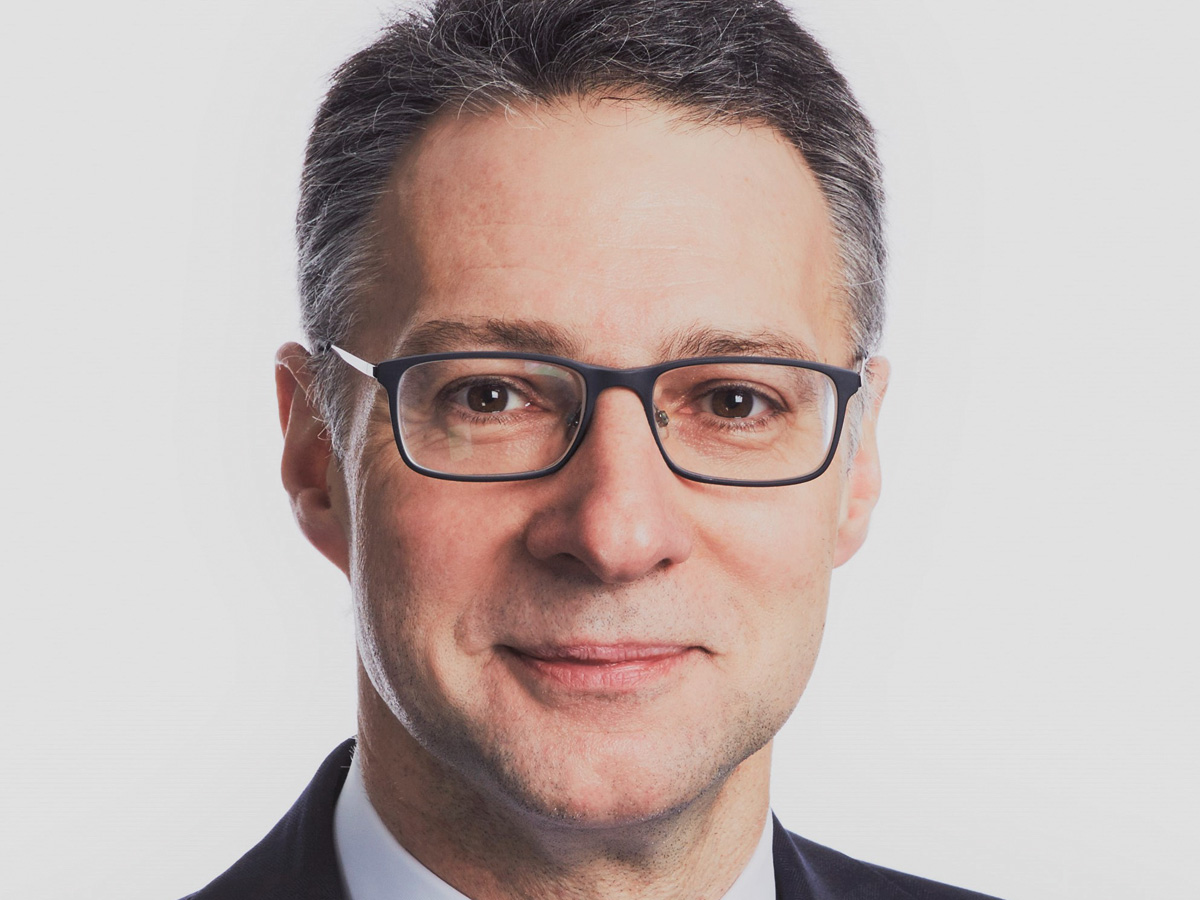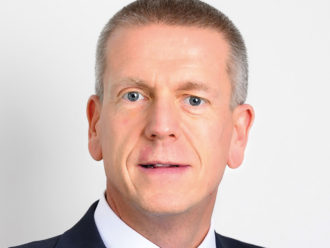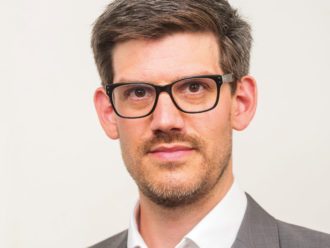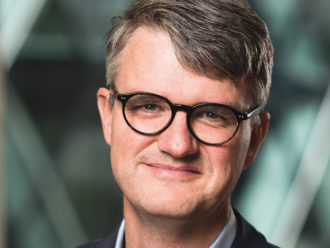Nest chief investment officer Mark Fawcett speaks with Mona Dohle about managing rapid growth, the transition to a low carbon economy and the sense of a common mission for auto enrolment providers.
We are going to be one of the largest pension funds in the UK in the coming years.
Nest recently received Financial Conduct Authority (FCA) approval to launch Nest Invest as an occupational pension scheme. What will change as a result of that?
Initially relatively little will change. There are two reasons for doing this. One, while good governance has always been at the heart of the way we have ran the scheme, we are getting bigger. We are going to be one of the largest pension funds in the UK in the coming years and we want to make sure the governance scales up with the organisation. Having a Nest Invest board as well as the FCA oversight helps us to make sure that the governance is well aligned with the scale that we are going to have.
In addition, and just as importantly, it will allow us to invest more flexibly in the coming years. As you are aware, we are now moving into private markets and there will be some co-investment opportunities as a result. The Nest Invest structure allows us to make decisions on those co-investments, such as how much money to commit. That is something we anticipate being able to do in the future. So it is about building up the knowledge base to do that.
We now take in more than £400m a month. By setting up the OPS structure, we will have the flexibility to manage the cash using derivatives where appropriate to make sure we have sufficient portfolio management.
The third element is that we can give regulated advice to our investment committee. When we go through our manager selection exercise, which we have done for many years, in the past we had to get an investment consultant to sign it off. We don’t need to do that now. We continue to use investment consultants where we want additional special input, but it is not a standard. So when we do a manager selection exercise now we can give regulated advice.
It is about continuing to make sure that we have the resources and the capability to handle the scale of taking in £5bn a year.
What are the challenges in growing at such scale?
We designed the scheme with a target date fund structure. We always designed it with a view that we needed to scale up. We have never gone into a niche asset that could only accept £1m or £2m over five years.
But the scale is also creating opportunities. Investing in private markets, for example, is something we couldn’t have done three years ago, apart from property which we’ve had for some time. Now we have discussions with fund managers about getting access to private markets at competitive prices.
Your assets are growing at £400m a month and you predict that by the end of the decade a third of the UK’s workforce will have a Nest pension. Will it be possible to always be fully invested?
Because the majority of the portfolio is liquid, the money comes in and the next day it is fully invested, but there are challenges. For example, initially we had a sterling credit corporate bond mandate but have expanded that to a global corporate bond mandate because the global markets are deeper and more liquid. So we were getting to the point where we had to have a conversation with our sterling credit manager because we were at risk of swamping their capacity. That’s why we went on to search for a global manager and appointed Wells Fargo.
We are bigger now so when we search for new mandates we get more competitive pricing than we did five years ago.
Does the high growth rate of your scheme mean you only invest with larger asset managers?
We can go with boutiques but they have to demonstrate that they have the sourcing capacity in private markets and the asset management capacity in public markets. For example, we chose CoreCommodity to manage our commodity fund. All they do is mange commodities so in that sense they are a boutique, although they are not tiny as they have a decent amount of assets. We will find high quality managers, we believe we can build a partnership with them and are ambivalent about their size provided that they can manage the cash-flows, which is generally easier for larger funds.
What will be the role of the in-house investment team under the new structure?
At the moment the two key roles are asset allocation and manager selection. Those will continue to be what we do, albeit we are investing in more sophisticated asset classes. Responsible investment, which has always been important to us, increasingly means integrating climate change risk management right across the portfolio.
It is about having the flexibility to design the mandate, having segregated accounts, and instruct the managers more interactively. Those are the key things. The core functions won’t change, the level of sophistication will.
If you look at some of the big pension funds – Railpen and USS – these are the things that they have been doing for a long time. Some have taken the decision to manage more money in-house, some have outsourced everything. That is something trustees will want to think about in the future, but we are not close to that yet.
Has it been a challenge to source active asset managers given the charge cap?
It is always challenging to make sure you find someone to partner with in the long term. But anytime we have run a search for a manager we have been pleasantly surprised, and sometimes amazed, by the level of response and the competitiveness of pricing.
When we started talking about things like private credit there were people who said: “There is no way with your fee budget that you will ever get into private credit.” We have proven them wrong.
That is down to two things. One is obviously our scale and that we are going to be growing so strongly. Secondly, we create partnerships rather than just hire and fire managers. We always try to find managers we can stick with in the long term, get that knowledge transfer and build a good relationship.
There might be a third element, certainly for some managers. Nest has a strong sense of mission. We have played a powerful and important role in the auto enrolment process and people want to be associated with that. People realise that Nest is trying to be a force for good.
Since the financial crisis companies are talking more about how they want a sense of purpose. We have that sense of purpose and that is why people want to work with us.
How would you describe that sense of purpose?
We have 8 million members and they tend to be on low to moderate incomes. We have a lot of members who are paid the minimum wage; these are people who financial services typically don’t value as customers and rarely design products for. So we are focussed on designing our default fund, as well as other funds, to meet the needs of those members. For example, we know our members don’t like excessive volatility and that is one of our reasons for diversifying the portfolio and managing the risk you sometimes see if you just invest in stocks.
That brings us back to the whole active/ passive question. Equities started off as completely passive. We now have a combination of passive-plus, what we call systematic or what some people call smart beta investments. For example, our Climate Aware Fund is systematically tilting towards renewables and away from heavy carbon emitters. Because it is more cost effective and we are a low charge scheme, we need to make sure that we can develop the equity strategy which is always going to be at the heart of our funds and to do so in a low cost way.
In addition to that, things like credit need to be actively managed because if you just track the benchmark you end up being invested in the most indebted companies. You want to make sure you will get your money back, so active management is important. Illiquid asset classes have to be actively managed as well.
We have a lot of members who are paid the minimum wage; these are people financial services typically don’t value as customers and rarely design products for
Are there opportunities for active management in the equity space?
It is unlikely that we would select a fully active equity manager because the cost is prohibitive, but we see benefits to systematically tilting away from market cap. Managing climate risk is a top priority and that’s why we designed our Climate Aware Fund. The other thing is that it is hard for an active equity manager to manage billions of billions of pounds and outperform.
Do you think that as DC funds grow that there might be more room for investments in alternative asset classes and actively managed strategies?
I am not terribly optimistic that other schemes will do so. The advantage that Nest has is that because of our scale we are able to access these alternative asset classes. There is a lot of focus on cost so unless you have the scale it is hard to move away from just passive equities. Some schemes, especially the larger DC schemes, absolutely can but smaller schemes are going to struggle to do that.
Why has Nest expanded its allocation to private credit in the past year?
We have a long-term investment horizon. Our youngest member is 16 years old and we are going to be investing for her for maybe 40 to 50 years. There is certainly a lot of appetite for liquidity risk given that we are so cash-flow positive. The biggest challenges with illiquid assets are getting the money in at a sensible illiquidity premium and the cost aspect. Private credit is the lowest cost of the illiquid asset classes, which is one of the reasons why we started there. On top of that, public credit spreads have been so compressed by low interest rates and QE that we felt our credit portfolio needed an extra boost. There are some more defensive elements available as well. Infrastructure debt, for example, offers steady cash-flows, credit worthy projects and you get a premium to public market debt. It is relatively safe debt because it is secured against assets which is hard to get in the public credit market. From a volatility and defensiveness perspective, there is some attraction. Because we can take a long-term view, we welcome the illiquidity risk. It is something we are getting paid for and are happy to have.
Now, the next move as you are aware is that we have launched a search for an infrastructure manager. It is a similar investment case. There are also attractions to it when we think about managing climate risk. In infrastructure we are looking for three different mandates. One global, one renewables and one UK infrastructure.
So the renewable mandate is part of your Climate Aware Fund?
The aim of the whole portfolio, not just the equities, is to transition to a low carbon economy. That is one of the key initiatives in the coming years.
Are you directly engaging with companies or is this something you have outsourced?
It is a combination. We have a small investment team so we can’t do too much engagement ourselves. We still discuss with our fund managers how that engagement is going to take place and who they have been engaging with. We help steer those conversations.
UBS are our biggest manager. They were highly rated recently for how they vote in shareholder resolutions on climate change. Our engagement for the Climate Aware Fund focusses on some of the biggest carbon emitters in the world. That is quite a powerful story and collaborative engagement with other pension funds and asset managers is important. We were encouraged to see BlackRock also sign up to Climate Action 100, so there is a real sense of stated purpose emerging on how companies should respond to climate change.
One of our private credit managers is BNP Paribas. It has excluded lending to coal and tobacco companies. When we chose our managers – which include Amundi, BNP Paribas and BlackRock – we selected firms with strong ESG credentials.
Across all asset classes, the aim is to think about how we integrate climate aware investing. In our commodities fund we exclude investments in thermal coal, there are certain companies in that portfolio which are excluded, such as Glencore, for example.
We now need to think about bonds, and emerging market bonds in particular, and how we can integrate them for the management of climate change risks.
We are just trying to push that right through the portfolio.
That will be a project over several years. The climate aware portfolio is the heart of our climate change risk management but that can’t be the whole of the story.
Looking at the largest equity holdings in the Ethical Fund, they include Apple and Microsoft, which many members might not see as that ethical?
The Ethical Fund excludes specific sectors, either through hard or soft exclusions. The hard exclusions include tobacco, arms, adult entertainment, while the soft exclusions tend to not be in extractive industries. We are also increasingly concerned about stranded assets and announced last year that we were going to be tobacco-free across all our portfolios. The default fund makes investment decisions purely based on investment risk and return, the Ethical Fund does too, but makes additional decisions based on values. In the Ethical Fund you will not find an arms manufacturer, but in the default fund you might because not everyone is opposed to arms.
You have to make assumptions about people’s values, but would you engage with Apple on their labour standards?
Yes, we push our managers to do that. Engagement is important, that is why the Ethical Fund excluded Amazon when the engagement failed and the company didn’t meet their ethical criteria, but it can’t exclude all companies.
What will be the biggest challenges for Nest in the next 10 years?
To keep the money performing well is always the challenge. We need to seek out good opportunities. My sense is that global growth is probably going to be slower than it has been during the past 20 years, partly because China can’t carry on growing at 10% per year, and similarly India. But also, as the world transitions to a low carbon economy, there may well be a break on growth in certain areas. We just need to seek out the opportunities that can benefit from that transition, doing that at a low cost will be challenging but that’s what I am paid to do.




